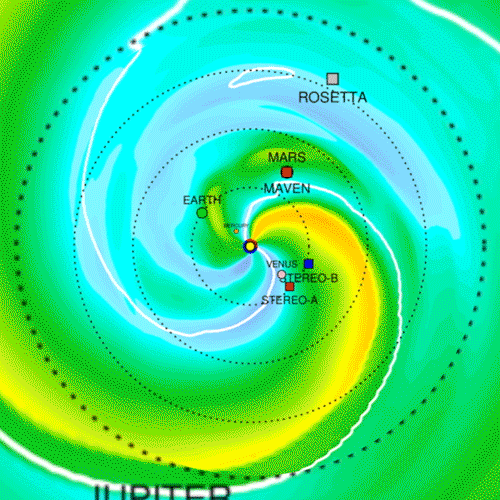Solar Storm Sentries: Spacecraft at Mars, Saturn and More Spot Huge Sun Eruption (Video)
Orbiters and probes across the solar system picked up a massive ejection of plasma hurled from the sun in October 2014, as shown in a new NASA video.
Over a period spanning years, the coronal mass ejection first reached our satellites surveying the sun from near Earth, then the Curiosity Mars rover and other Red Planet orbiters, then the European Space Agency's Rosetta spacecraft at comet 67P, and then NASA's Cassini probe, which is now about to take its "Grand Finale" dive into Saturn's atmosphere, NASA officials said in a statement. NASA unveiled the video on Aug. 15.

Researchers eventually pinpointed seven satellites and probes that directly felt the stream of plasma, including ESA's Venus Express. It may also have been picked up by NASA's New Horizons spacecraft, which sped out past Pluto in July 2015, and NASA's Voyager 2 probe, which is currently near the edge of the sun's sphere of influence.
However, NASA scientists were unable to verify that the charged particles detected by those two probes (New Horizons in January 2015 and Voyager 2 in March 2016) came from the same powerful blast as the rest of the measurements. New Horizons doesn't have a magnetometer to allow it to measure magnetic fields, and Voyager 2 is too far out for researchers to be certain of the source of the particles it detected, NASA officials said.

Coronal mass ejections happen when the sun's magnetic-field lines twist and snap, releasing vast streams of charged plasma out into space. While the material can take hours to detach from the sun, the charged plasma speeds away from it at more than 7 million mph (11 million km/h).
Editor's Note: Space.com senior producer Steve Spaleta contributed to this report.
Email Sarah Lewin at slewin@space.com or follow her @SarahExplains. Follow us @Spacedotcom, Facebook and Google+. Original article on Space.com.
Get the Space.com Newsletter
Breaking space news, the latest updates on rocket launches, skywatching events and more!
Join our Space Forums to keep talking space on the latest missions, night sky and more! And if you have a news tip, correction or comment, let us know at: community@space.com.

Sarah Lewin started writing for Space.com in June of 2015 as a Staff Writer and became Associate Editor in 2019 . Her work has been featured by Scientific American, IEEE Spectrum, Quanta Magazine, Wired, The Scientist, Science Friday and WGBH's Inside NOVA. Sarah has an MA from NYU's Science, Health and Environmental Reporting Program and an AB in mathematics from Brown University. When not writing, reading or thinking about space, Sarah enjoys musical theatre and mathematical papercraft. She is currently Assistant News Editor at Scientific American. You can follow her on Twitter @SarahExplains.









